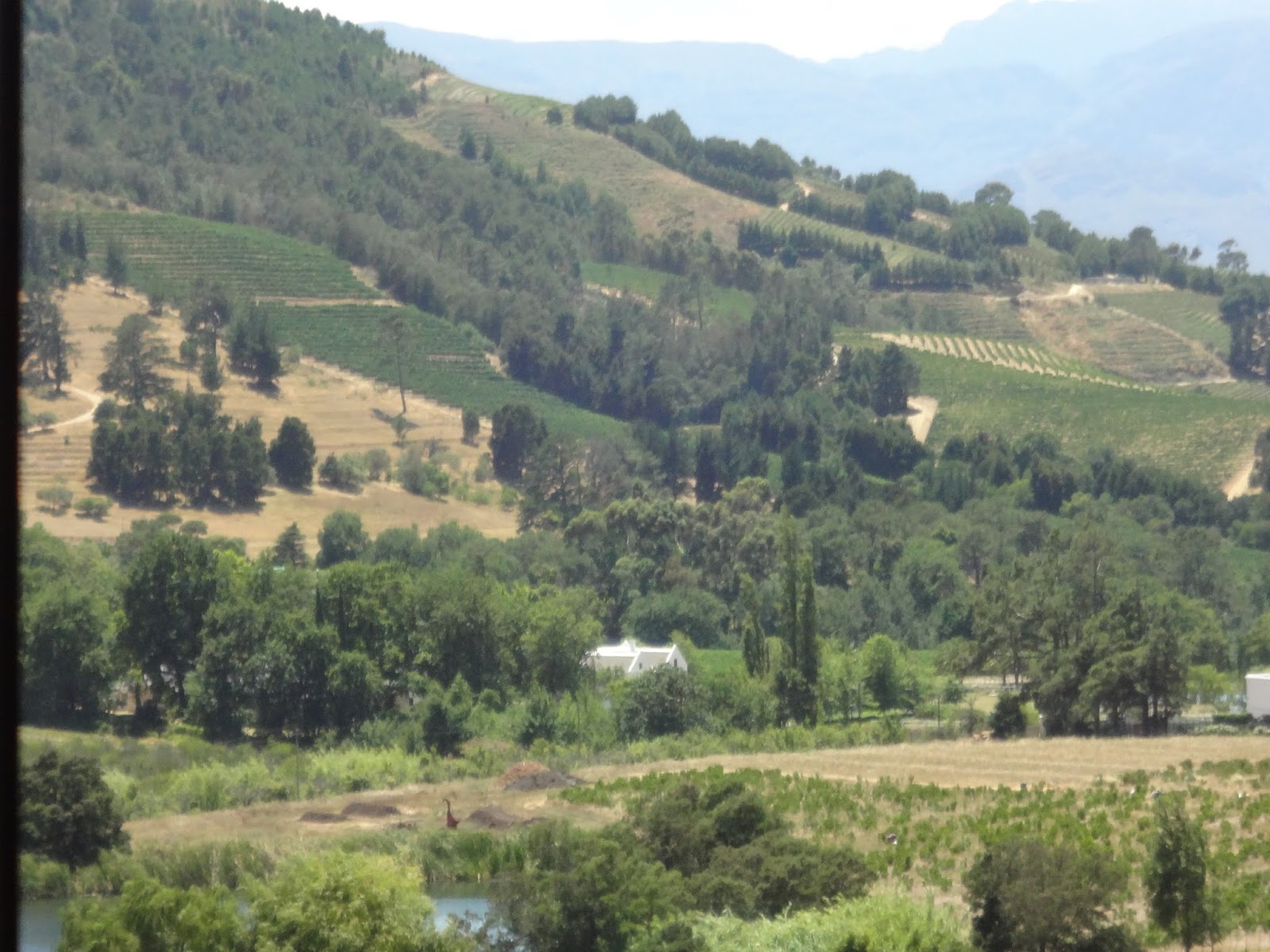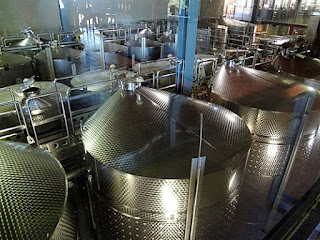Our first stop on our Afrivista Tours winery tour was at Tokara. The estate used to be a fruit tree estate that is now fruit, grapes and olives. They make wines, olive oils and balsamic vinegars. So of course, they had olives to cleanse the palate between wines. I'm not a big olive fan, but decided to try the ones here. I'm actually going to voluntarily put an olive in my mouth....

Yeah, it was ok. I actually had several after that and was still smiling. Or is that a grimace?
That's Bill, Jim, Tracy and me tasting the olive oils at Tokara. I bought a small bottle of the blended one, but the straight olive oils tasted a bit harsh to me. Jason and Bill review some of the reading materials at Tokara. This was a very comfortable and modern wine tasting room that set a new standard for South Africa wine tasting when it opened. Very posh and nice!
The second winery, Camberley, was much more of a home/family oriented place and the big yellow dog greeted us.
This fancy tricycle is made of old machinery parts welded together at Fairview, our third stop.
Jason thinking he's Easy Rider on a junk trike.
Linda had a hard time getting on the contraption.
We had a cheese pairing with our wines after lunch and we're hearing our host tell us about them. A bit stingy with the tiny cheese samples, but the cheese shop was connected and had many more samples we were free to try, so we went around a couple of times and bought several cheeses here--a couple different flavors of goat cheese and a white rock/cheddar with cranberries. The white rock and figs was a close runner-up for purchase, and I found it in a store later and bought some.The oak tree here is 317 years old, planted by the owners of the original Muratie winery on their wedding day back then. I gathered an acorn that had dropped from the tree.

Karen and Jason being tree huggers. It's a big, old tree!
The constant whitecaps just keep rolling in to Cape Town on the day we visited to buy boat stuff.
The Tokara wine estate also boasts a sculpture garden. This one was in the parking lot when we pulled in. If you walk around the grounds of the estate, you'll see sculptures that have been placed all around the estate. You can bike around on the pathways and see them all, but we didn't have time on our tour to do so.
Grape vines are in the front, but the grey-green in the background is the olive grove. Each grape vine produces enough grapes to make about two bottles of wine, so our guide suggested we picture a bottle of wine hanging from each side of the vine. Quite a picture that would be, eh?
A view out towards the ocean with new tree plantings in the foreground,
Some of the grapes just getting ripe. We tasted the grape varieties off the vine here.Tokara's modern entry is marked by this tree sculpture. On all the branches are words that might be associated with wine.
The winery supports the local university art students. They give each art student two bottles of red wine--one for drinking and one for painting. The entire entry area was a gallery of paintings done by these students and they are done only with the red wine. Some were excellent, and this was one of my favorites.
Another artistic sculpture at Tokara.
These are local plants and flowers (fynbos) embroidered in bright colors and hung behind the tasting bar.
Jim, Bill and Jason tasting one of the red wines. It was a leisurely start to our tour and we enjoyed this winery immensely.
Tracy and Linda enjoying the red wine. Such professional holds on the glasses, too.
A clock made especially for this place in the entry gallery. Very old pieces in a very modern setting.
You could overlook the winery vats through large glass walls in the tasting area.
A very picturesque part of the country, this wine producing region. The wineries only water their grapes 3-4 times a year. The grapes should be able to make it on their own in nature, but with the drought and fires here, they give them a bit of help a few times a year.

The low-key welcome at the second winery by this friendly pooch.

We are actually in one of the storage cellars here and we shared the room with barrels full of wine.
A cute arrangement at the bar.
Bill is our designated driver and doesn't look like he's having as much fun as the rest of us.
They use small pieces of sulphur like this one to clear the oxygen out of the barrels so the wine doesn't turn sour.

Our guide, Andre, shows us how they light a piece and then hang it from a string in the barrel to remove the air.
Some of the bottles laid up for storage at Camberley.
The dog decides to cool off in the fountain outside as we are leaving for lunch.
A view of the Stellenbosch area where a lot of wine is made here in South Africa. "We make some pretty good wines here in South Africa, but it is the geology that makes the great wines", our guide told us. Microclimates make all the difference to the different varieties of grapes and they have dozens of microclimates here. The air here rises from the oceans and visibly cools into the clouds we see on the mountaintops every day. Different grapes grow best at different levels up the mountainsides and in the different soils. South Africans have learned to use this information to make better wines and have surpassed the French in award-winning wines.
At the last winery, we saw some of the grapes they were just starting to pick and were testing for sugar levels.
A modern piece of equipment is used to crush the grapes and remove the stems and seeds. No more stomping with the feet in a giant barrel....darn.
This is one of the owner's sons and he is testing the grape juice from the crushed grapes. He let us all taste it, too.
These grapes still look like they have some juice in them to me.
And this is what you want to drink??? It's still way to early in the process to even think about it.
The Muratie winery used to use these large concrete casks to store the wine in . They kept the wine cool and at a constant temperature as they are under ground.
The Muratie estate has been growing wine grapes since 1699. The original grower was the first to combine the Pinot Noir and Hermitage grapes to produce a new grape called Pinotage, now one of the most popular grapes used for making and blending wines. Here an old bike leans against the 2014 barrels of Vintage Port wine. This winery is known for its ports.

Muratie is also famous for its spider webs in the bar. The windows here haven't been cleaned since 1970 and they let the spider webs grow unimpeded. They hang everywhere here in this room. They were burgled a few years ago and the lower center window was broken into. You can see it is recovering nicely with its new growth of webs.
The tasting room at Muratie. The walls here are lined with art that the owner painted. He was quite good, I think.
This nude was of the owner's mistress and was discovered in a group of twelve paintings hidden away until after his death. Only one of the paintings showed this woman with any clothes on.
All the black in this large wall hanging is tiny black beads stitched into this pattern of a crest. Very intricate and meticulous work that would've taken a very long time to make.
Live proteas on the table. They feel like hard plastic. They are a symbol of the area here in South Africa.
One of the big concrete casks has been opened up and made into a room here in the winery. Linda is smelling the walls as they say you can still catch of hint of the wines that used to be in here years ago.
A painted bit of wall at the winery near the bar.
Linda getting her tree hugs in, too.
Some of the feathers I found under the tree. Guinea fowl and Egyptian goose left many feathers here for some reason.
The clouds over the mountains in Stellenbosch. A place near here where the clouds are pushed between two ridges is the wettest place in South Africa.

A shanty town between Simon's Town and Stellenbosch. Mostly blacks live here and some of the artists that bring their wares to the sidewalk markets daily come from here. It's really a large town of low-rise humble housing.




















































No comments:
Post a Comment